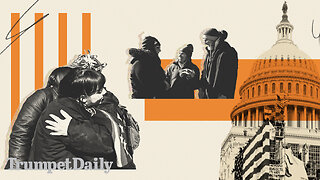Premium Only Content

The Bill of Rights was originally not The Bill of Rights as we know it
Articles 3 to 12, ratified December 15, 1791, by three-fourths of the state legislatures, constitute the first 10 amendments of the Constitution, known as the Bill of Rights.
source: archives.gov
Bill of Rights (1791)
Although 12 amendments were originally proposed, the 10 that were ratified became the Bill of Rights in 1791. They defined citizens' rights in relation to the newly established government under the Constitution.
During the debates on the adoption of the Constitution, its opponents repeatedly charged that the Constitution as drafted would open the way to tyranny by the central government. Fresh in their minds was the memory of the British violation of civil rights before and during the Revolution. They demanded a "bill of rights" that would spell out the immunities of individual citizens. Several state conventions in their formal ratification of the Constitution asked for such amendments; others ratified the Constitution with the understanding that the amendments would be offered.
On September 25, 1789, the First Congress of the United States therefore proposed to the state legislatures 12 amendments to the Constitution that met arguments most frequently advanced against it. Articles 3 to 12, ratified December 15, 1791, by three-fourths of the state legislatures, constitute the first 10 amendments of the Constitution, known as the Bill of Rights. Article 2 concerning “varying the compensation for the services of the Senators and Representatives” was finally ratified on May 7, 1992 as the 27th Amendment to the Constitution. The first amendment, which concerned the number of constituents for each Representative, was never ratified.
-
 1:02:58
1:02:58
Flyover Conservatives
1 day agoA Doctors Response to Trump’s First Moves: W.H.O. and FDA - Dr. Troy Spurrill; A REAL-LIFE Approach to Health and Wellness Transformation - Kellie Kuecha Moitt | FOC Show
86.9K6 -
 41:50
41:50
State of the Second Podcast
10 hours agoWhat do Gold and Guns have in common?
40.1K4 -
 1:01:26
1:01:26
PMG
6 hours ago $2.68 earnedLibs In FULL PANIC Since Trump Took Office! Creating a Faith to Fit their Agenda
28.9K9 -
 7:09:22
7:09:22
Dr Disrespect
14 hours ago🔴LIVE - DR DISRESPECT - TRIPLE THREAT CHALLENGE - EXTREME EDITION
258K32 -
 55:00
55:00
LFA TV
14 hours agoThe End of the January 6 Hoax | TRUMPET DAILY 1.22.25 7pm
48.6K12 -
 1:13:37
1:13:37
Battleground with Sean Parnell
12 hours agoPresident Trump Is On FIRE w/ Savage Rich Baris
187K27 -
 1:59:59
1:59:59
Melonie Mac
8 hours agoGo Boom Live Ep 34!
79.4K14 -
 49:27
49:27
Sarah Westall
7 hours agoTrillion Dollar 5G Lawsuit, Project Archimedes, Mind Control & DEW Weapons w/Attorney Todd Callender
80K38 -
 53:11
53:11
Standpoint with Gabe Groisman
1 day agoTrump Is Crucial For Hostage Agreement Says Israeli Colonel
56.6K5 -
 1:01:22
1:01:22
Anthony Pompliano
1 day ago $1.57 earnedTrump Inauguration Sends Bitcoin Flying
40.2K4